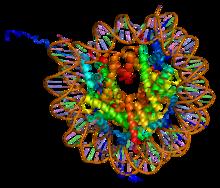Histone H2A
Histone H2A is one of the five main histone proteins involved in the structure of chromatin in eukaryotic cells. Featuring a core component of the nucleosome, which is the primary building block of chromatin, Histone H2A plays a critical role in the regulation of gene expression, DNA repair, DNA replication, and chromosomal stability.
Structure and Function[edit | edit source]
Histone H2A, like other histones, has a highly conserved structure across many species, indicating its essential role in the cell's life. It consists of a globular domain and a flexible, charged N-terminal tail. The globular domain is involved in the formation of the nucleosome core, around which DNA is wrapped, while the N-terminal tail undergoes various post-translational modifications that influence chromatin structure and function.
Histone H2A variants, such as H2A.Z and H2A.X, have been identified and are involved in specific aspects of chromatin function. H2A.Z is associated with gene regulation, whereas H2A.X plays a crucial role in the DNA damage response by becoming phosphorylated at sites of DNA breaks.
Histone H2A in Gene Regulation[edit | edit source]
The positioning of Histone H2A within the nucleosome can affect access to DNA by transcription factors and other regulatory proteins. Modifications to the N-terminal tail of H2A, such as acetylation or methylation, can either promote or inhibit transcription. For example, acetylation of H2A is generally associated with transcriptional activation, whereas methylation has been linked to repression.
Histone H2A and DNA Repair[edit | edit source]
Histone H2A.X becomes phosphorylated at serine 139 (a modification known as γ-H2AX) in response to DNA double-strand breaks. This modification serves as a signal for the recruitment of DNA repair proteins to the site of damage, facilitating the repair process. The presence of γ-H2AX is therefore a marker of DNA damage and an essential component of the cellular response to DNA damage.
Evolutionary Significance[edit | edit source]
The conservation of Histone H2A across eukaryotes underscores its importance in the maintenance of chromatin structure and function. Variations in H2A and its post-translational modifications have been linked to the regulation of specific genes and pathways, reflecting the adaptability of chromatin structure to different cellular and environmental conditions.
Conclusion[edit | edit source]
Histone H2A is a fundamental component of the chromatin architecture, playing a vital role in gene expression, DNA repair, and maintaining chromosomal integrity. Its study continues to reveal the complex mechanisms by which chromatin dynamics are regulated and the importance of histone modifications in cellular processes.
Navigation: Wellness - Encyclopedia - Health topics - Disease Index - Drugs - World Directory - Gray's Anatomy - Keto diet - Recipes
Search WikiMD
Ad.Tired of being Overweight? Try W8MD's physician weight loss program.
Semaglutide (Ozempic / Wegovy and Tirzepatide (Mounjaro) available.
Advertise on WikiMD
WikiMD is not a substitute for professional medical advice. See full disclaimer.
Credits:Most images are courtesy of Wikimedia commons, and templates Wikipedia, licensed under CC BY SA or similar.
Contributors: Prab R. Tumpati, MD




